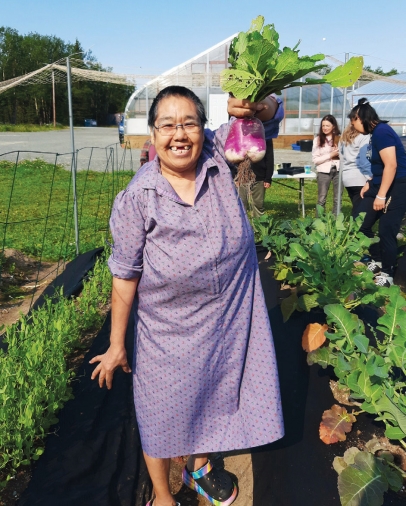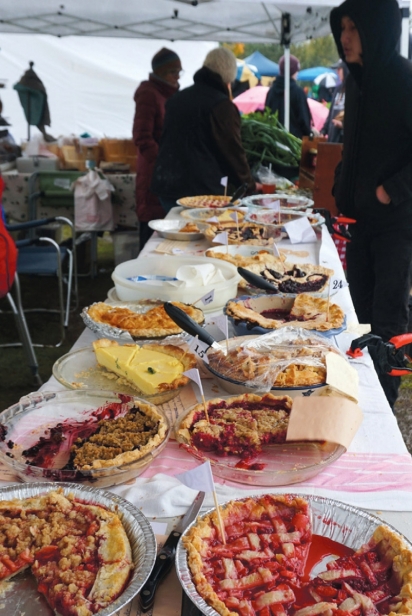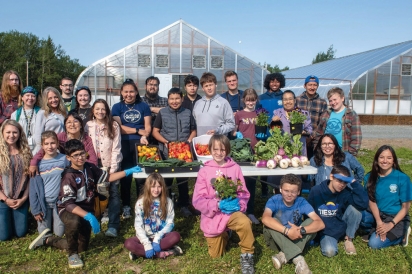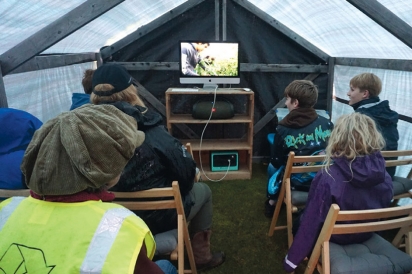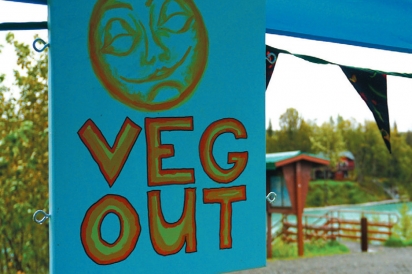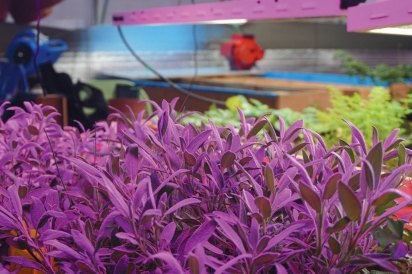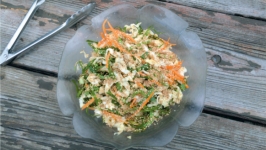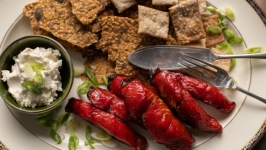Spinning the local food web
Rain and wind marked the Harvest Moon Local Food Festival last September. In Soldotna Creek Park, bystanders rushed to re-stake the Kenai Peninsula Food Bank’s tent after it took flight.
Still, locals clad in a colorful array of raincoats arrived early. Vendors asked if they could begin selling before the official start time. As puddles grew on the soggy, trampled grass, so did the crowd.
Ten local farms sold produce. Food trucks displayed signs featuring local ingredients. The Central Peninsula Garden Club, University of Alaska Fairbanks Cooperative Extension Service, USDA Farm Service Agency, and Alaska Farm Bureau hosted educational booths. The Last Frontier chapter of the International Dutch Oven Society served free chili and cheese rolls.
Willow King, owner of The Goods + Sustainable Grocery, rolled up in her van just as the festival was about to start. Soon, tie-dyed tablecloths and piles of local carrots sat next to trays of rice ready to be fried.
Close to the stage, Grace Acres Farm occupied several tents, their crates overflowing with produce. More stacks of vegetables waited behind their display.
Tia Holley, founder of Indigenous Herbals Inc., sat behind a table stacked with products. At the demo tent, Traditional Healer Karen Trulove discussed spruce needle rust, a fungal disease now common on the peninsula. Jessica Newton, Greenhouse Coordinator for the Dena’ina Wellness Center, presented on microgreens. Local chefs crafted a wild seaweed salad.
Across the way, co-founder Eliza Eller and others from the community of Ionia stood under the bright yellow Fermentation Station tent helping festivalgoers preserve purchased veggies.
Harvest Moon is a celebration of the strong, diverse strands woven between food-related organizations on the peninsula. Each fall, the Kenai Local Food Connection (KLFC) convenes volunteers to set up tables, monitor recycling, and provide support during the festival. That mostly locals attend speaks to the success of KLFC’s mission.
“Farmers sell more at Harvest Moon than they do everywhere else,” Eller said. “It just has this spirit to it.”
This hard-working optimism is at the heart of the movement to grow local food and nourish the community. KLFC and its partners do this work not only because they care, but also because they know that this—local food at the center of a local economy—is how we survive.
Much of the Kenai Local Food Connection’s work happens behind the scenes, and involves fostering the kinds of relationships that draw people to the park on a rainy day.
KLFC’s mission is to connect local food growers, consumers, and advocates within communities throughout the Kenai Peninsula. From their start over a decade ago as a group of women who met through a public health initiative, they’ve accomplished this by bringing together volunteers from diverse professions and organizations.
One of these is Ionia, an intentional community located in Kasilof where Eller and several other KLFC members live. Not surprisingly, one of Ionia’s core values focuses on natural and local foods. The community shares several high tunnels and harvests wild foods. In Eller’s cabin at Ionia, buckets of grains and beans line the Arctic entry. A group of kids gravitates toward the kitchen and huddles around a large bowl. They announce that they are making a sauce for their fried rice.
Eller finds hope in the young people joining KLFC, especially those from Ionia who were raised on local food. Watching the kids cook their veggie-filled snack, it was easy for me to find hope in them, too.
KLFC has forged connections through Farm and Food breakfasts. They’ve created the Kenai Peninsula Local Food Directory, a pamphlet listing farms, markets, and businesses offering local food products. During COVID, the “connectors,” as they sometimes call themselves, partnered with Willow King and her shop in Soldotna, The Goods + Sustainable Grocery, to offer “stay healthy” food boxes packed with local veggies, organic fruit, and soup to over 30 low-income families in our community.
“There’s a gap around here between the consumers and the farmers,” Eller said, and KLFC has worked to close it. As climate-related disruptions increase, “watersheds are going to have to take care of themselves.”
Though she wouldn’t say so, Willow King is vital to the success of the peninsula’s food web. Vegan and gluten-free folks have found an oasis at her small business. When asked about her role with KLFC, she quipped it was “generally to feed people at meetings.”
Among her many roles, King connects young growers with established farmers to foster apprenticeships. She worries about the aging population of producers and has seen that for newcomers, affordable land is hard to come by.
“If we want to have an agricultural boom in Alaska, we have to give people land and teach them how to use it,” King said. Suitable land exists, especially here on the peninsula, but young farmers must be able to access it.
Still, she sees hope in the very population she’s trying to lure through the doors. Some small-scale farmers have been able to sell produce to The Goods that other venues wouldn’t consider. This fall, King’s business was approved to accept SNAP benefits, aligning with KLFC’s “Double Up” program which increases the value of WIC and senior farmers market coupons in summertime.
King believes people will continue to become more mindful about food, to find their passion and place in the local food web. Despite the odds, she identifies as an “eternal optimist” who wants to make sure we “walk the food talk.”
“We’re screwed if we don’t,” she said.
For those who don’t live here, the communities of the Central Kenai Peninsula often fade into the highway, a fuel stop on the drive from Anchorage to Homer. I haven’t met many people who associate Soldotna with fresh carrots or local vegan cuisine.
Kenai Peninsula farmers “have had to figure it out,” said Amy Seitz, lifelong resident and third-generation farmer. “The farmers have built it.” The resilience of smaller operations like Lancashire Farms—which Seitz runs with her family—speaks to what the farmers have built.
As Executive Director of the Alaska Farm Bureau (among other roles), Seitz also advocates for agriculture in Juneau. She has connected with KLFC as both advocate and farmer.
People need local foods during disasters like the pandemic or big storms, Seitz said, but they don’t realize that these foods can’t materialize without a steady market. Organizations like KLFC can foster consistent support of local agriculture.
Seitz hopes to see KLFC continue to coordinate advocacy, particularly in local and state legislations. “You almost have to be in everything,” she said.
KLFC’s sprawling, multi-layered work aims to do exactly that.
In a conference room at the Dena’ina Wellness Center in Kenai, we talk fish. The Dena’ina people have stewarded the lands and waters of the Kenai Peninsula for millennia. They are the inheritors of finely honed knowledge about how to survive—and eat—in this region.
“The irony in Alaska Native people being the most food insecure is that traditionally they lived off what the land and waters provided for 10,000,” said Tawna Duncan, Wellness Director for the Kenaitze Indian Tribe.
Subsistence fishing rights are paramount for the Kenaitze members, who want to pass on the knowledge of how to live in this place to the next generation. As Tia Holley, a traditional wellness consultant for the tribe and KLFC member, pointed out, though, “people adapt.” As the tribe fights for access to traditional foods, they are also investing in growing their own produce to share in accordance with traditional values.
Trays of microgreens, beds of sage, and the last of the season’s tomatoes adorned one of Kenaitze’s greenhouses when I visited in November; the other still had watermelon on the vine. On a table at the entrance, KLFC’s Local Food Directory sat next to containers of Holley’s dena’ina huldulyi muscle rub and a jar of smoked salmon.
The knowledge and guidance of elders permeates every aspect of the tribe’s relationship to local foods. The elders asked for a seed-saving program for local medicinal and food plants, so Holley started saving nettle seeds. Elders participate in activities at the greenhouse and enjoy fresh produce at the Tyotkas Elder Center.
These connections across generations forge a resilient food web. Though food insecurity continues among the Kenaitze, there is much in their approach that KLFC and other local food advocates could learn from.
“If we want to have an agricultural boom in Alaska, we have to give people land and teach them how to use it.”
There is also momentum in teaching people how to use local foods. “There are moms with young families who don’t know how to cook,” Karen Trulove said of the need for this education. “There are families who eat every meal out of McDonald’s.”
These are concerns that everyone in the local food scene shares. It is not enough to provide access to healthy foods—and even that is not simple.
Holley, who has been involved in KLFC for many years, remembers telling her former boss, “Sometimes I think I’m just there to remind people that the most local food is right outside your door.”
Back at the festival, Lancashire Farm sold vegetables and yarn. The Alaska Farm Bureau hosted a pie contest. On the riverfront, KLFC member Susan Nabholz presided over a collection of tents devoted to children. A team of student volunteers painted faces and helped make veggie necklaces.
A wooden frame wrapped in tarps and blankets housed a mobile theater, where Nourishing the Kenai, a short documentary, ran on repeat.
The film, produced by Emerys Eller (Eliza’s son), features the families of Grace Acres Farm and Ridgeway Farms, among others. One young volunteer jumped up and rushed to the door. “I think we might know one of the people in the film!” he gushed. “I think they might be here.”
A few weeks later, the connectors gathered at The Goods to reflect. They discussed vendors for next year, and where the film might be shown. Soon enough, they turned to funding opportunities. The energy in the room pointed toward expansion, toward the work that was yet to be done.
We’re approaching a watershed moment in deciding how we will weather the coming storms. What will food security look like? Who will it include? To engage these questions, KLFC has spun a web of resources, organizations, and people who want to see local food—and all those who eat it—thrive.


